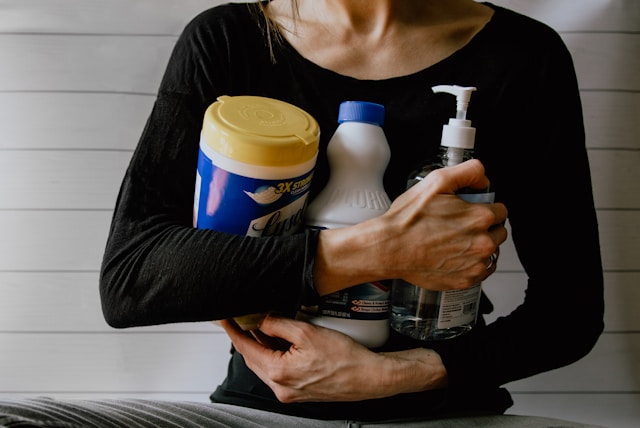Everything in your home contributes to your family’s health. Dirty dishes in the sink, paint on the walls and the sounds you hear make up your home’s wellness profile. Some are more dangerous than others but become easy to handle with a little awareness. These six surprising health dangers may not be common knowledge, but you can avoid them by taking action.
1. Indoor Air Quality (IAQ)
You might have heard of IAQ before. Many smart devices measure your home’s air. They detect harmful contaminants like volatile organic compounds (VOCs), radon, and carbon monoxide. Knowing what can be harmful and how present it is is the first step to overcoming polluted air. It prevents associated health effects, like reproductive problems and cancer.
However, numerous parts of the building contribute to low air quality you may not have known. Lead paint has VOCs, but so do some local woodworking business and carpet fibers. Per- and polyfluoroalkyl substances (PFAS) get into the air and water through common household products, like toilet paper, nonstick cookware and raincoats. You may not live near agriculture, but pesticides are so pervasive they could sneak into your home, too.
Install a monitor to detect as much as possible, then review all purchases from now on. Many products have labels to tell customers if they are free from contaminants like VOCs, PFAS, and chemicals. As a bonus, you can also get air purifiers and improved ventilation.
2. Hidden Mold Growth
People expect mold to thrive in dark, wet corners of the home, but mold can surprisingly be anywhere — even in a potted plant. Bathrooms, basements, vents and crawl spaces are perfect for tiny but mighty fungi, but it can take a long time to see or smell mold. Instead, you’ll more likely feel the physical symptoms first, including respiratory problems or skin irritation.
You must understand there is no way to combat these health concerns unless you control moisture. You can get inexpensive home mold tests or contact an inspector for a deep-dive inspection. Dehumidifiers also make it more challenging for mold to grow. Additionally, add more ventilation to wet areas, like kitchen exhaust fans or bathroom vents.
3. Household Chemicals
You’ve experienced a cough or two after spraying a particularly harsh cleaner. Extended usage could lead to throat and breathing problems. However, the startling side effects of prolonged carcinogenic chemical exposure include this long list of bodily damage:
- Cardiovascular problems
- Gastrointestinal distress
- Sensory damage
- Immunotoxicity
- Musculoskeletal effects
- Connective tissue damage
- Endocrine system toxicity
You should replace store-bought cleaners with alternatives. Kitchen staples, like vinegar, baking soda and lemon are antibacterial, antiviral and deodorizing. These make potent yet safe eco-friendly alternatives that don’t hurt you, your children or your pets.

4. Poor Lighting And Its Effects
Inadequate lighting has a wider impact on the home than you think. If there isn’t enough light in the house, your eyes are constantly strained. Add blue light from the screens you’re looking at all the time, and you make matters worse.
Inability to access natural light or constantly being under low light conditions can also impact your mental health. It worsens feelings of anxiety and depression, and it can reduce motivation and productivity.
Another danger is poor outdoor lighting. Approaching the home at night could be precarious. A stray rock could cause someone to trip and cause a surprise visit to the emergency room. Additionally, you want sufficient lighting outside to prevent safety concerns from intruders. Install motion-detecting or smart lights to schedule them for specific hours of the day.
5. Clutter And Its Impact On Mental Health
If your space is cluttered, your mind might feel similar. Researchers have shown a correlation between disorganization and wellbeing. Piles of stuff leave an unexpected mark on the brain. They overload many cognitive functions and, subsequently, take up space in your working memory.
When you boost the mood of everyone in the house, you’ll notice a greater willingness to prioritize their physical health. Decluttering could improve time management, stress and sleep. Clarity in the space brings focus to your tasks as well, relieving anxiety related to procrastination or lags in productivity.
6. Unmaintained Appliances and Electronics
Did your cat chew up some fairy lights and expose wires, or is a device in the rarely visited basement leaking a noxious gas? Appliances and electronics can pose various health hazards, including air quality compromises and electrical hazards that could turn into a fire.
Studies show exposure to electronic waste harms children and people who are pregnant. It’s a detriment to neonatal growth and hormone levels. Other wild side effects include DNA damage and reduced vaccine responsiveness.
Safely dispose and upgrade appliances before unforeseen health problems arise. Reach out to your city to see if they have programs to pick-up large electronics. Nonprofits may also help find end-of-life destinations. You could also see if your local electronics store has a recycling program, such as Staples or Best Buy.

Happy Home, Happy Life
You may have never considered how light could protect your family from intruders or how a nonstick pan could make having your next child difficult. Overcome these health dangers by making a few changes in your home now. Get that dehumidifier or replace the disinfectant. You’ll be pleasantly surprised how much happier your body feels surrounded by a cleaner home.






